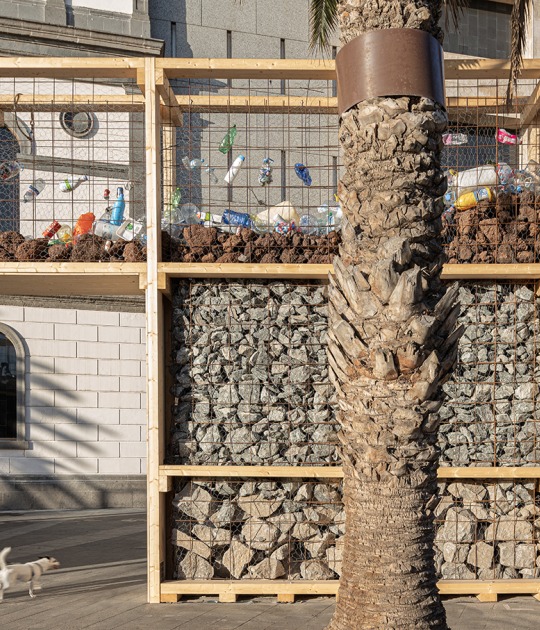A winding gravel path leads to an area of outdoor seating. The sun, hitting the orange, blue, pink and red-clad structure with its rays, causes the reflection of glasses plunges the brick wall with a full spectrum of colours, in stark contrast to the surrounding landscape.

Vertical Panorama Pavilion by Studio Other Spaces. Photograph by Adam Potts.

Vertical Panorama Pavilion by Studio Other Spaces. Photograph by Adam Potts.

Vertical Panorama Pavilion by Studio Other Spaces. Photograph by Adam Potts.
Project description by Studio Other Spaces.
The Vertical Panorama Pavilion enables a unique encounter between our senses and our surroundings. The design for the pavilion aims at creating a holistic experience that is based on a journey through several horizontal layers of the site, landscape and surrounding elements – resulting in a type of vertical panorama.
All design elements are abstractions of components taken from a vertical slice through the pavilion’s specific location. We begin with the experience of the crunching sound of our shoes on the gravel path, and acknowledge the fragrances from surrounding flora as well as the soil as not only the ground we walk upon but also a home for precious roots and microorganisms, take in the orchestra of sounds created by the winds, the rustling grass and chirping insects, move along the ground and follow the stream of the occasional fog and mist, and finally turn our attention towards the blue sky above and the various formations of clouds. Passing through this sequence of vertically aligned layers forms an abstract section through The Donum Estate.
The ephemeral conditions of the area set the prerequisites for making great wine. And our approach to capturing a vertical cut of all these circumstances aims at giving an overview that influences the experience in all our senses. One arrives at the property, walking up a path slightly upward sloped. The path guides the visitor in an s-curve, the destination ahead not visible except for the glass roof contrasting the ephemerals. The roof’s coloured glass tiles represent an abstract calendar that depicts yearly averages of the four meteorological parameters sight, wind intensity, temperature and humidity, while we continue our walk and the wall to one’s right slowly rises, bringing smells, sounds and new perspectives close to our senses.
Vertical Panorama Pavilion by Studio Other Spaces.
A path leading to and from the pavilion is carved into the slope. One physically enters into the realm of the soil. The path itself rests on a compacted surface topped with gravel. The wall that separates us from the hillside is made up of earthy bricks, one side glazed with a mirrored surface and stacked in a way that suggests an additional element of movement. While walking along the path and into the pavilion, the wall grows higher, to finally reach eye level. Our eyes, ears and nose are now in line with the turf, where earth and sky meet alongside rich biodiversity.
After this walk, we reach the pavilion, the gathering area underneath the oculus. Once everyone has arrived, the group is accompanied to their seats in the actual tasting space, sitting below the turf. A view over the valley unfolds, the seating arranged to lay special emphasis on the view to the south and the bay. The benches can be arranged according to group sizes, their dimensions enabling a closeness to the ground, one’s body becoming physically aware of the soil, the surrounding species and all elements necessary for creating the wine one is about to taste. Leaning back and relaxing, one’s eyes wander from the breath-taking view upwards, to the roof’s coloured elements, finally focusing on the oculus and sky beyond. The glass tiles form a complex weather calendar for visibility, wind intensity, temperature and humidity.
The pavilion offers a unique experience of the specific qualities of the site, represented in an arrangement that specifically shifts our attention to the elements surrounding us. Vertical Panorama Pavilion creates a state of mind and body that aims at enhancing the wine tasting, making the experience of the wine itself unique and not repeatable – every day at The Donum Estate is inimitable, leaving a deep impression imprinted in our memories.









































